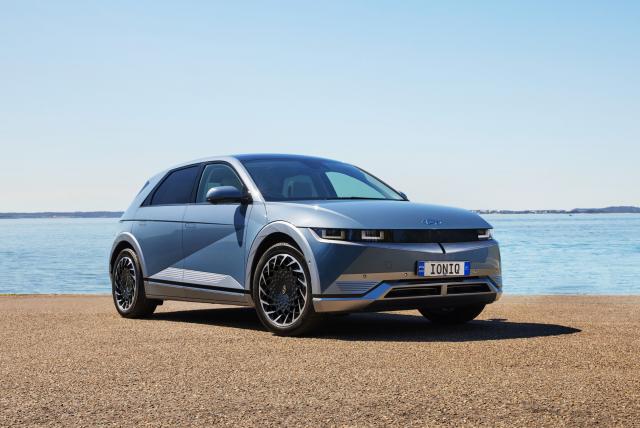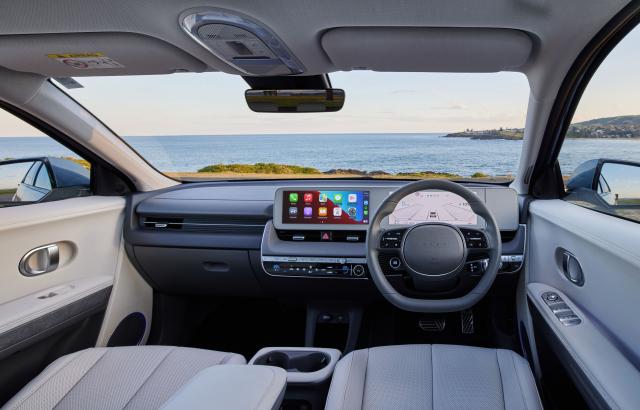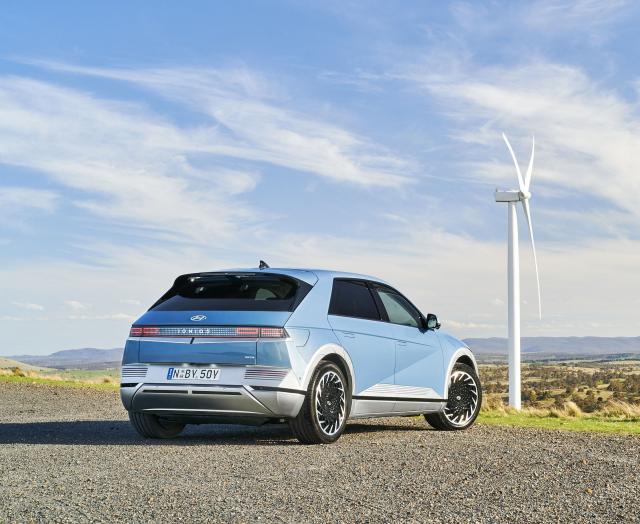Those cheeky chaps from Monty Python may well have had the new IONIQ 5 in mind when they coined their “And Now For Something Completely Different” catch-phrase.
A futuristically-styled mid-sized SUV, the IONIQ 5 is Hyundai’s first-ever dedicated battery-electric vehicle as distinct from the Kona SUV and IONIQ hatchback models which also come with hybrid and plug-in hybrid variants.
Although it carries Hyundai badging, the SUV IONIQ 5 is the first vehicle from the Korean company’s new sub-brand and joins the luxury Genesis marque but with EV only models. The existing IONIQ hatchback variants (hybrid, plug-in hybrid and EV) will continue to be sold as Hyundais, but future dedicated EV including a sedan (IONIQ 6) and large SUV (IONIQ 7) will sell join the IONIQ 5 under the new brand name.
IONIQ 5 is available in one grade, with the option of a rear-wheel single motor layout or a dual motor (rear and front) AWD. Our test car was the AWD variant with Hyundai’s HTRAC multi-mode system and in metallic Galactic Grey, one of six exterior colour options.
STYLING
As always there will be opposing opinions about external styling and that’s even more likely when something as adventurous as IONIQ 5 comes along. We absolutely loved everything about it, a few were non-committal, while a couple hated it. One thing that was consistent as we drove the car around for a week was that it didn’t go un-noticed.
Although EVs don’t need a conventional grille most models to date have been based on petrol or hybrid vehicles any so usually end up with a closed-off version of the grille.
Because IONIQ 5 is all-new from the ground up its designers have been allowed to let their creative juices run free. The front of the car features two narrow glass strips, the top one with twin rectangular LED headlamps outside of orange turn indicators on either side and sensors and a camera in between.
Below there’s a full-width string of LED daytime running lights beneath while at the bottom there is a pair of air flap that opens when needed to provide cooling to the various pieces of componentry above.
On the side a diagonal crease runs from high in the front doors down to the base of the rear ones with a neat lined panel at the bottom of the doors. The door handles sit flush against the doors and pop out when unlocked. The wheels are 20-inch alloys with a complex design.
Throughout the exterior of the IONIQ 5 car there’s a small square design that’s most noticeable at the rear lighting panel with, as at the front, the name in the centre and rectangular taillights surrounding the turn indictors.
INTERIOR
The innovative design features continue inside the IONIQ 5
Comfort features include a heated steering wheel, heated and ventilated front seats, heated rear seats and an adjustable centre console. The front seats are 12-way power adjustable and come with a ‘Relaxion’ (zero gravity) mode. Perfect for lying back and having a quick nap while the car is charging.
IONIQ 5 has a three-metre wheelbase and that contributes to a level of rear legroom that you’d get in a luxury sedan. All seats are power adjustable with a memory function which can be set through the digital display screen.
A vision glass roof with a powered sunshade is standard in both models.
There are a number of “why didn’t someone think of that before?” features including a padded bar that runs the length of the interior doors instead of conventional handles, a glovebox that slides in and out and a small magnetic pad on the right edge of the display panel where you can pin notes, photos, etc.
The charge point is at the rear driver’s side with both AC and DC sockets. The cables are located under the front bonnet including a very clever Vehicle to Load device which plugs into the car’s AC port at one end and a standard power plug at the other allowing for multiple uses including providing power to another electric vehicle.
During our week we found a practical use when we had a black-out at home but were able to plug in a kettle and have a welcome cuppa while we waited for the power to come back on. Amazing!
Full charge through a standard domestic power point is upward of 24 hours. However, it’s likely that anyone buying an EV will invest around $2000 in a home charging wallbox. This will reduce charging time to around six hours while an ultra-fast charger can charge from 10% to 80% in around 18 minutes.
We’re currently in the process of having a wallbox installed at our home office by JET Charge, Australia’s leading installer of EV charging equipment who partner with Hyundai as well as most other EV brands including Tesla, Volvo, Porsche and Audi. We’ll do a follow-up News story to report on how it all works out.
DRIVETRAIN
The IONIC 5 RWD has a single 72.6 kWh battery mounted at the rear and producing 160kW of power and 350 Nm of torque with a listed WLTP range of 451 km.
The AWD version has batteries at the front and rear with outputs of 225 kW and 605 Nm but less range, at 430 km.
INFOTAINMENT
The IONIQ 5 has two 12.3-inch screens embedded into a single panel. A digital instrument cluster in front of the driver and a Multimedia navigation unit in the centre.
There are three USB ports at the front and two more at the rear with 12-volt sockets at the front and another in the boot.
Wired-only Android Auto and Apple CarPlay compatibility is standard as well as wireless smartphone charging. Sound is through a BOSE eight-speaker premium audio system.
Satellite navigation includes details of the closest charging stations and a driving radius on how far the battery will allow the car to reach.
SAFETY
Standard safety features include seven airbags; front and rear autonomous emergency braking; front and rear parking sensors; blind spot monitoring including camera coverage; lane departure warning; lane keep assist (which can be temporarily turned off by those of us who like to steer the car ourselves without interference); smart radar cruise control; rear cross-traffic alert; safe exit alert; rear seat occupant alert; driver inattention alert; and an interactive surround view monitor including a 360-degree overview; remote smart parking assist which allows the car to be moved remotely; and two ISOFIX child seat mountings.
DRIVING
Pressing the unlock button on the key fob opens the door handles which sit flush against the sides of the car.
The driver’s seat is comfortable and supportive and the overall ambience of the interior sets the scene for an enjoyable travel experience. The driving position is fairly high even with the intrusion of the sunroof and visibility in all directions is excellent.
The chunky steering feels great but does tend to obstruct the driver’s view of the instrument panel and the steering wheel-mounted gear selector.
We love driving electric vehicles at the best of times but the IONIQ 5 takes that enjoyment to an even higher level. It cruises effortlessly and with such a large amount of instant torque on offer it can accelerate sharply when needed.
Smart regeneration braking to extend range can be adjusted through steering wheel paddles including an i-Pedal feature which allows single-pedal driving.
There are three drive modes: Normal, Eco and Sport.
The only downside with the IONOQ 5 is in the ride and handling especially through corners where we found ourselves backing off. Typically, most Hyundai and Kia models gain the benefit of local input into their cars’ tuning but that didn’t happen with the IONIQ 5, possibly because of Covid-19 travel restrictions.
SUMMING UP
Motoring journalists are inevitably asked what their favourite car is. After spending a week behind the wheel of the IONIQ 5 it has certainly earned a podium spot and, with the expected ride and handling tweaks, would likely move to the top spot.
We love its exciting styling both outside and in its bright, spacious and airy interior.
No review of an EV can be complete without reference to the price / range equation. All EVs are very expensive when compared to conventional vehicles, including hybrids. At $71,900 for the IONIQ 5 RWD and $75,900 for the AWD it sits at the higher end of the segment.
Offsetting the high price, its potential range of up to 450 kilometres makes it more practical than many of its competitors.
If you’re willing to trade-off a lower range for a more affordable price a base model IONIQ 5 will arrive here at a date to be advised later.
Standard warranty is five years with unlimited kilometres. There’s an eight-year, 160,000 km battery replacement warranty,









